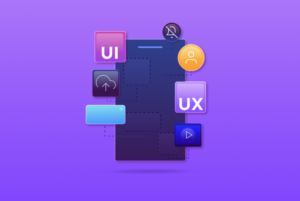
Choosing the right UX/UI design tools is crucial to creating user-friendly and visually appealing digital content. With manufacturing equipment evolving so rapidly, choosing the best fit for your business and manufacturing process can be challenging. In this post, we’ll explore the top 10 UX/UI design tools for 2024, highlighting their features, pros and cons to help you make an informed decision.

1. Figma
Figma is one of the cloud-based tools that allows designers and stakeholders to collaborate in real time. It has gained tremendous traction due to its ease of use and flexibility.
- Features: collaborative design, vector mesh, prototyping, system design, plugins, and version history.
- Pros:
- real-time performance and responsiveness.
- Extensive plugin ecosystem.
- Browser-based, no installation required.
- Free plan available for small groups.
- The downside:
- Performance may lag with large files.
- Limited offline capabilities.

2. Adobe XD
Adobe XD is a powerful tooling and prototyping tool from Adobe, seamlessly integrated with the Adobe Creative Cloud Suite.
- Features: Vector-based design, prototyping, voice prototyping, component environment, integration with Adobe Creative Cloud, plugins.
- The benefits:
- Simple interface for Adobe users.
- Good integration with other Adobe apps.
- Responsive resizing and iterative network features.
- The downside:
- Limited vector editing compared to Adobe Illustrator.
- Fewer plugins compared to Figma.
3. Sketch
Sketch has long been a favorite of UX/UI designers because of its intuitive and robust design, although it’s only available on macOS.
- Features: vector editing, reusable symbols, prototyping, cloud collaboration, system design management.
- The benefits:
- Simple and clean interface.
- Powerful vector editing tool.
- Multiple plugins for extensive functionality.
- The downside:
- Available only on macOS.
- Limited prototyping features compared to Figma and Adobe XD.

4. InVision Studio
InVision Studio provides the perfect platform for screen design, rapid prototyping, and collaboration.
- Features: screen design, advanced animation, prototyping, collaboration tools, synthesis.
- The benefits:
- Advanced animation capabilities.
- A collaborative environment with real-time feedback.
- Integrated with the InVision Design System Manager.
- The downside:
- Steep learning curve for beginners.
- Business cases for large enterprises.

5. Axure RP
Axure RP is known for its robust prototyping and wireframing capabilities, especially for complex UX projects.
- Features: High-fidelity prototyping, dynamic content, situational understanding, process documentation, business tools.
- The benefits:
- It’s best to create detailed, interactive models.
- It supports arguments and complex situations.
- It generates functional descriptions.
- The downside:
- The comparison of the interface with other equipment is dated.
- Steep learning curve for new users.

6. Marvel
Marvell is a user-friendly tool known for rapid prototyping, testing and handoffs.
- Features: Rapid prototyping, programming, testing, handoffs, integration and popular tools like Sketch and Figma.
- The benefits:
- Easy to learn and use.
- It is effective for rapid prototyping and testing.
- Integrated experimental controls.
- The downside:
- Limited resolution capabilities compared to Figma and Adobe XD.
- It is less suitable for large production systems.

7. Framer
Framer is an interactive tool that allows designers to create high-reality prototypes with advanced animation interactivity.
- Features: Interactive design, high fidelity prototyping, React-based code export, integration and other tools.
- The benefits:
- Advanced interactive and animation capabilities.
- Code export for developers.
- Communities are strong resources.
- The downside:
- Advanced features require some knowledge of coding.
- Steep learning curve for beginners.

8. Balsamiq
Balsamiq is a wireframing tool that focuses on low-fidelity design and rapid idea generation.
- Features: virtual wireframing, drag-and-drop interface, reusable icons, and object integration.
- The benefits:
- It’s easy and quick to create a wireframe.
- Great for brainstorming.
- Easy to use with minimal learning curve.
- The downside:
- Limited for high fidelity system.
- Basic Prototyping capabilities.

9. Proto.io
Proto.io is a tool development tool that aims to create an interactive prototype without any coding.
- Features: Prototyping, drag-and-drop UI components, interactions and animations, business tools, usability testing.
- The benefits:
- Coding is not necessary for prototyping.
- Lots of UI components and libraries.
- Integrated usability testing.
- The downside:
- Not ideal for more realistic systems.
- Some things are not very clear.

10. Affinity Designer
Affinity Designer is a vector graphic design software known for its speed and accuracy.
- Features: Vector and raster layouts, customizable grids and directions, unlimited artboards, non-destructive performance.
- The benefits:
- Cheap one-time purchase.
- Powerful vector and raster editing capabilities.
- Smooth performance even with large files.
- The downside:
- There are no built-in prototyping features.
- Limited third party integration compared to Figma and Adobe XD.
Conclusion
Choosing the right UX/UI design tool depends on your specific needs, team size, and project scope. Tools like Figma and Adobe XD are great for collaborative design and prototyping, while Sketch is a strong choice for macOS users. InVision Studio and Framer are great for detailed animation interactions, and Balsamiq and Axure RP are perfect for wireframing and complex prototypes. Look at the features, pros and cons of each tool and find the best fit for your business.
0 Comments
No comments yet. Be the first to comment!












Post a comment